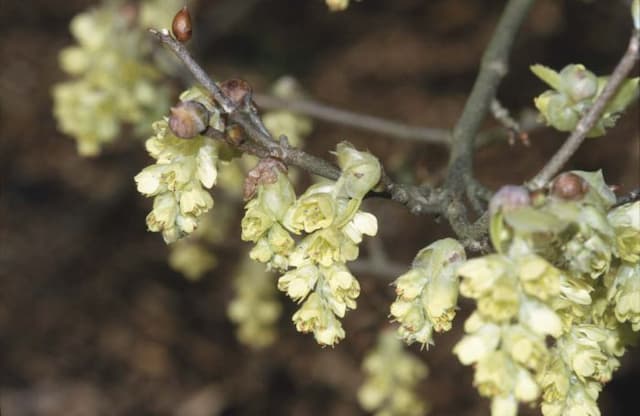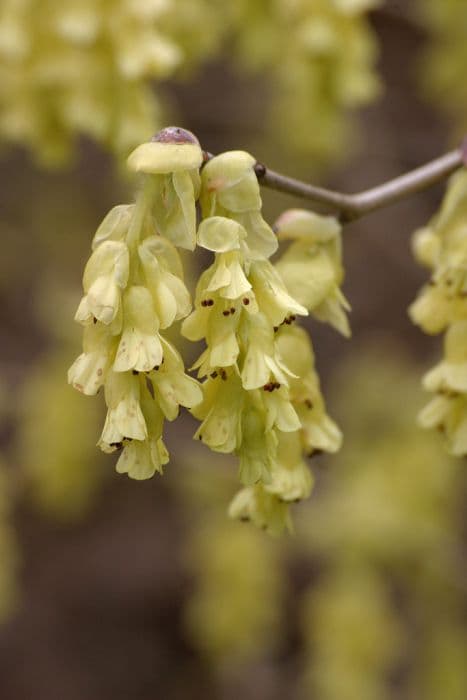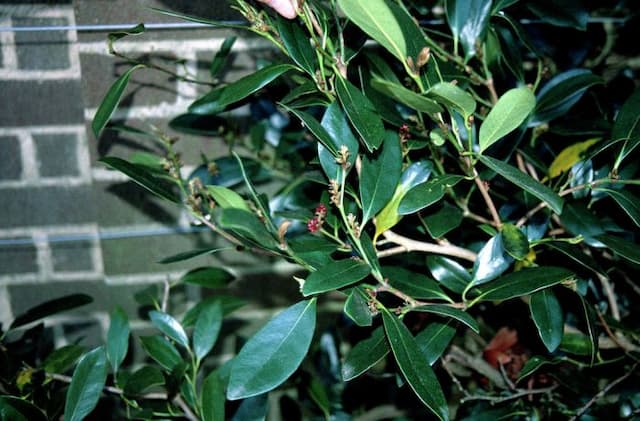Liquidambar styraciflua 'Worplesdon'

ABOUT
The 'Worplesdon' is a variety of the sweetgum tree, known for its distinctive star-shaped leaves and striking fall coloration. Its leaves display a montage of colors ranging from yellow through to orange, red, and sometimes even a deep purple in autumn. In spring and summer, the foliage presents a lush green, adding a vibrant feel to any landscape. The leaves are glossy, with elongated points that make up the star-like shape, contributing to the tree's ornamental value. In addition to its colorful foliage, the sweetgum tree produces peculiar spiky fruit. These fruiting bodies, known as gumballs, hang from the branches and persist into winter, providing a unique appearance even after the leaves have dropped. The bark of the sweetgum is another characteristic feature, being deeply furrowed and forming attractive, interwoven patterns that give the tree a chiseled texture. The Worplesdon's structure is pyramidal to oval when young, becoming more rounded with maturity. It possesses a dense canopy that offers significant shade during the warmer months. As a cultivar of sweetgum, it also shares the species' hallmark of having a symmetrical, straight trunk that provides a sturdy vertical accent to any setting where scale is not a concern. Despite being recognized for its aesthetic qualities, it's often chosen for its adaptability and hardiness in various soil conditions and urban environments.
About this plant
 Names
NamesSynonyms
American Sweetgum, Worplesdon Sweetgum, Redgum, Satin-walnut, Star-leaved Gum, Alligator Wood, Bilsted.
Common names
Liquidambar styraciflua 'Worplesdon'.
 Toxicity
ToxicityTo humans
The plant known as Sweetgum is not considered highly toxic to humans. However, if ingested, parts of the plant, particularly the seeds, can cause mild stomach upset in some individuals. There are no severe toxic reactions expected from ingesting this plant.
To pets
Sweetgum is not known to be highly toxic to pets. Like in humans, ingestion of seeds or other parts of the plant could cause gastrointestinal discomfort in some animals, but it is not expected to cause severe illness or toxicity.
 Characteristics
CharacteristicsLife cycle
Perennials
Foliage type
Deciduous
Color of leaves
Green
Height
40-60 feet (12-18 meters)
Spread
20-30 feet (6-9 meters)
Plant type
Tree
Hardiness zones
5-9
Native area
North America
Benefits
 General Benefits
General Benefits- Aesthetic Value: Offers stunning fall colors, ranging from yellow to deep red, adding seasonal interest to landscapes.
- Shade: Grows to a large size, providing ample shade in gardens, parks, and streets.
- Wildlife Support: Produces spiky fruit that is a food source for birds and small mammals.
- Durable Wood: The wood is hard and can be used in furniture making and other woodworking projects.
- Longevity: It is a long-lived tree that can remain a part of the landscape for several generations.
- Erosion Control: Extensive root system helps in stabilizing the soil and reducing erosion.
- Adaptability: Can thrive in a variety of soil types, though it prefers moist, well-drained acidic soils.
 Medical Properties
Medical Properties- This plant is not used for medical purposes.
 Air-purifying Qualities
Air-purifying QualitiesThis plant is not specifically known for air purifying qualities.
 Other Uses
Other Uses- Woodworking: The wood of the Sweetgum tree is used for fine woodworking and furniture making due to its satiny finish and ability to hold fine details.
- Crafts: The spiky gumballs, or seed pods, can be gathered to use in crafting, such as making holiday decorations or for creating eco-friendly mulch.
- Printing blocks: The fine grain of the wood makes it suitable for making printing blocks for art or textile printing.
- Beekeeping: Sweetgum trees are excellent nectar sources for bees, and the honey produced from Sweetgum flowers is prized for its unique flavor.
- Dye production: Sweetgum leaves can be used to create natural dyes for fabrics, with the leaves producing different shades of brown and gray.
- Landscape binding: The extensive root system of the Sweetgum makes it good for soil stabilization and preventing erosion on slopes or in areas with loose soil.
- Bonsai: Some horticulture enthusiasts use the Sweetgum tree to create bonsai due to its attractive leaf shape and color variability, particularly in the fall.
- Wildlife habitat: Sweetgum trees provide habitat and nesting sites for a variety of birds and small mammals in their natural environment.
- Environmental education: Sweetgum trees can be used in educational settings to demonstrate deciduous tree life cycles and the importance of biodiversity.
- Pond management: When planted near ponds or water features, Sweetgum trees can provide shade and reduce algae growth by limiting the amount of sunlight that penetrates the water surface.
Interesting Facts
 Feng Shui
Feng ShuiThe Sweetgum is not used in Feng Shui practice.
 Zodiac Sign Compitability
Zodiac Sign CompitabilityThe Sweetgum is not used in astrology practice.
 Plant Symbolism
Plant Symbolism- Change and Adaptability - The Liquidambar styraciflua 'Worplesdon', commonly known as the Sweetgum, is renowned for its vibrant autumn foliage, which transitions through a spectrum of colors, symbolizing the ability to adapt and flourish through life's changes.
- Healing and Medicine - Sweetgums have a history of medicinal use by Native Americans, where the resin-like sap, or storax, was used for various remedies, representing healing and the nurturing aspect of nature.
- Longevity and Endurance - As a tree that can live for many years, often over a century, the Sweetgum symbolizes endurance and the passage of time, reflecting the long journey of life and the wisdom that comes with age.
- Protection - With its sturdy wood and spiked gumballs, the Sweetgum can be seen as a symbol of protection, suggesting a safeguard against adversity and a reminder of the strength found in standing firm against life's trials.
 Water
WaterThe Sweetgum tree, commonly known as Liquidambar styraciflua 'Worplesdon', prefers moist, well-drained soil and should be watered thoroughly once a week during its growing season in spring and summer. During the dormant season in fall and winter, reduce watering to every two to three weeks depending on rainfall and soil moisture levels. Each watering session should provide the Sweetgum with approximately 10 to 15 gallons of water, ensuring it penetrates deeply to encourage a strong root system. In periods of drought, watering should be increased to twice per week, with each session providing the tree with up to 15 gallons of water to prevent stress.
 Light
LightSweetgum trees thrive best in full sun conditions, meaning they should receive at least six hours of direct sunlight each day. The ideal location for a Liquidambar styraciflua 'Worplesdon' is an open space, away from buildings or other trees that could shade it, ensuring it gets ample light throughout the day for healthy growth and vibrant fall foliage.
 Temperature
TemperatureSweetgum trees like Liquidambar styraciflua 'Worplesdon' are hardy and can survive in a wide temperature range, typically withstanding minimum winter temperatures down to -10°F. However, they grow best in temperate climates where temperatures range from 70°F to 85°F during the growth season. They can tolerate summer highs up to 100°F but should be monitored for signs of heat stress.
 Pruning
PruningPrune the Sweetgum tree during its dormancy in late winter to early spring to remove any dead, diseased, or damaged branches and to maintain its desired shape. Liquidambar styraciflua 'Worplesdon' typically requires light pruning every few years to keep the tree healthy and prevent potential hazards. The best time for pruning is after the coldest part of winter has passed to minimize stress on the tree.
 Cleaning
CleaningAs needed
 Soil
SoilSweetgum prefers a slightly acidic to neutral pH, ideally between 5.5 to 7.5. A good soil mix for Sweetgum includes loamy topsoil with organic compost and a small amount of sand to improve drainage. Ensure that the soil is fertile and well-draining to prevent waterlogging, which Sweetgum roots dislike.
 Repotting
RepottingSweetgum trees do not require frequent repotting as they are typically planted outdoors. They are usually planted directly in the ground where they can thrive without the need for repotting. Repotting is generally not applicable to this species unless it starts in a container for initial growth before transplanting.
 Humidity & Misting
Humidity & MistingSweetgum trees are adaptable to a range of humidity levels and do not require specific humidity conditions to thrive. They grow well in the varying outdoor humidity levels that occur naturally within their hardiness zones.
 Suitable locations
Suitable locationsIndoor
Not suitable for indoor growth due to size.
Outdoor
Plant in well-draining soil with full sun exposure.
Hardiness zone
5-9 USDA
 Life cycle
Life cycleSweetgum 'Worplesdon' begins its life as a seed, which, after being dispersed, requires a moist, well-drained environment to germinate. Once germinated, it enters the seedling stage, growing rapidly with enough light, water, and soil nutrients, developing a distinctive, star-shaped leaf pattern. The juvenile stage is marked by vigorous stem and leaf growth, and it's during this period that the tree begins to establish its pyramidal shape. As the tree matures into adulthood, it develops the characteristic corky ridges on its bark, and during its reproductive stage, it produces distinctive, spiky seed balls that disperse seeds in late autumn. The Sweetgum 'Worplesdon' has a long adult phase, during which time it may reach heights of 60 to 70 feet and can live for many decades, providing valuable habitat and autumn color. Eventually, the tree enters the senescence stage, where growth slows, and it may become more susceptible to disease and environmental stress before eventually dying.
 Propogation
PropogationPropogation time
Late Winter-Early Spring
The most popular method of propagating the Sweetgum tree, specifically the Liquidambar styraciflua 'Worplesdon', is through seed collection and sowing. Seeds are typically gathered in the fall after the spiky seed balls have dried and begun to break apart. It's important to collect the seeds once they're fully mature but before they disperse naturally. Once collected, the seeds are cleaned and stratified. Stratification involves chilling the seeds for 1-3 months at 33-41°F (0.5-5°C) to break dormancy and improve germination rates. After stratification, the seeds are sown in well-draining soil in a sunny location. Sowing should ideally occur in late winter or early spring, with germination expected in a few weeks to a couple of months, depending on conditions.









